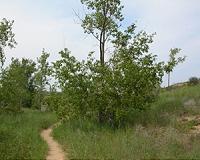 |
Chitwan, Nepal (AFP) Dec 15, 2010 The lush jungles of the Chitwan national park in southern Nepal are among the last remaining refuges of the endangered royal Bengal tiger and the rare one-horned rhino. But conservationists say the huge wildlife reserve is under threat from a foreign invader that is destroying its delicate eco-system, with potentially catastrophic implications for the animals that live there. Over the past decade and a half, a non-native creeper dubbed "mile-a-minute" for its rampant growth has covered large swathes of the 932-square-kilometre (579-square-mile) park, a major tourist attraction and UNESCO world heritage site. Biologist Naresh Subedi says the plant, micania micrantha, has already engulfed more than a third of prime rhino habitat in the national park, and believes the impact on wildlife could be devastating. "Micania is ranked as one of the most invasive plants in the world," said Subedi, who works for the National Trust for Nature Conservation (NTNC) in Chitwan. "It can smother, choke and pull over other plants, it causes soil erosion, and no single technique has yet proved effective for its long-term control. "More than a third of the rhino habitat in Chitwan has now been covered to a greater or lesser degree, posing a serious threat to the population." Although micania is edible, it is nutritionally deficient compared to the native grasses of Chitwan which can sustain "mega-herbivores" like rhinos which require a large, daily intake of nutrient-rich vegetation. Native to South America, micania grows over the plants that make up the diet of the rhinos, blocking the sunlight they need to survive. A single plant can produce between 20,000 and 40,000 seeds, which are dispersed by wind, and its shoots are reported to grow by up to 2.7 centimetres (about one inch) a day. Micania is thought to have been introduced to South Asia during the second world war as a form of camouflage for military bunkers in India. It was later used on Indian tea plantations to cover exposed strips of soil in an effort to prevent erosion, and was first reported in the east of neighbouring Nepal in 1966. The threat to the rhino population comes as numbers are beginning to recover after a 10-year Maoist insurgency in Nepal, during which poachers were given free rein as soldiers protecting the park left to battle the rebels. The last count, in 2008, found 408 rhinos living in Chitwan, the second largest population in the world and up from 372 in 2005, a year before the conflict ended. The NTNC recently fitted eight of the rhinos with radio collars and staff now conduct regular patrols to monitor their movements, sometimes spending all night in the park. They want to establish whether the spread of micania is forcing the rhinos to move to new areas of the park, or worse, leave altogether to seek new sources of food. Perched precariously atop a giant elephant -- the favoured mode of transport in the jungle -- chief wildlife technician Bishnu Bahadur Lama holds a metal aerial aloft as he listens out for a radio signal on his receiver. From the top of the elephant, the devastating impact of micania is clear to see. Huge trees have been completely covered by the weed and now lie dead beneath it. "Sometimes we see the rhinos eat the micania," said Lama, who has worked in the national park for 36 years. "We don't yet know what the long-term effect on them will be, but we are concerned that their droppings will spread the weed even further." Conservationists say the park's tigers, already hunted to the brink of extinction, will also suffer if the deer and other herbivores they prey on are hit by the diminished availability of food. Bengal tigers were once found throughout Nepal's southern lowlands, which border India, but poaching and the destruction of their natural habitat have drastically reduced numbers. A World Wildlife Fund (WWF) survey carried out two years ago found just 121 tigers of breeding age living in Nepal, most of them in the Chitwan national park. WWF conservationist Rinjan Shrestha is working on a national strategy to control the spread of the weed, which he says is critical to the survival of rhinos and elephants in the park. But he acknowledges it will be difficult. No reliable method of killing the weed without harming the vegetation around it has yet been found, although experiments with a fungus that poisons it are being conducted in India. "We are drafting a plan of action in consultation with the government and seeking funds from donor agencies," Shrestha told AFP. "We are consulting with the government and looking for donor funding, and we expect to be in a position to undertake control measures next year. But we will need continuous engagement and it will be highly costly."
Share This Article With Planet Earth
Related Links Forestry News - Global and Local News, Science and Application
 A Study Analyzes The Movement Of Tree Sap
A Study Analyzes The Movement Of Tree SapMadrid, Spain (SPX) Dec 15, 2010 The researchers decided to embark on this study in order to find out which mechanisms are used by plants when they extract water from very dry or somewhat inhospitable land. "In the case of mangrove swamps, for example, the plants are able to extract freshwater from a saltwater environment, despite the fact that the osmotic pressure should make quite the opposite happen", explains Professo ... read more |
|
| The content herein, unless otherwise known to be public domain, are Copyright 1995-2010 - SpaceDaily. AFP and UPI Wire Stories are copyright Agence France-Presse and United Press International. ESA Portal Reports are copyright European Space Agency. All NASA sourced material is public domain. Additional copyrights may apply in whole or part to other bona fide parties. Advertising does not imply endorsement,agreement or approval of any opinions, statements or information provided by SpaceDaily on any Web page published or hosted by SpaceDaily. Privacy Statement |